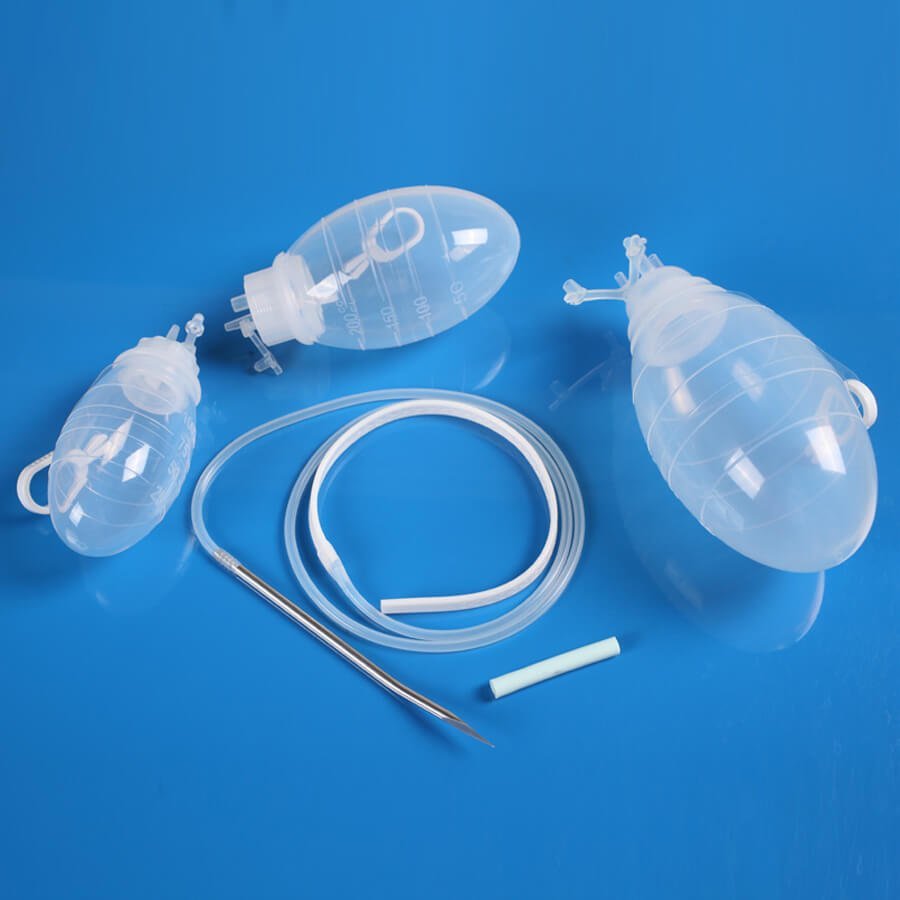The Use of Drains in Breast Augmentation Surgery
The use of drains is one of the applications that patients are most curious about. In this article, I aimed at providing detailed information about the structure, function, and advantages and disadvantages of these small tubes, which are used not only in breast augmentation but also in many other plastic surgery procedures.
What is a Surgical Drain (Drainage Tube)?
A drain is a tube with a diameter of 3-10 mm, made of silicone or plastic, equipped with a measuring reservoir at its transparent end where liquids accumulate, used to remove (drain) the blood and fluid accumulated in the surgical site in the postoperative period.
One end is inserted into the surgical site, and the other is taken out through a separate incision made near the armpit. The reservoir, where the liquid accumulates, is equipped with a mechanism that helps discharge the liquid by vacuuming at various degrees.
In the days following the surgery, it is decided whether these drains will be removed by observing the color and amount of the discharged fluid.
When blood and tissue fluids accumulated in the surgical site after a breast augmentation operation are not discharged from the body, they are usually absorbed by the body in the next few postoperative days and do not lead to a serious problem. However, excessive amount of fluid accumulation in the surgical site, as observed in some patients, may cause undesirable conditions such as increased pressure in the surgical site, pain, increased stress on the suture lines, circulatory disorder, or infection.
The use of silicone tubes eliminates these problems, but there are some disadvantages. Especially when the patient moves, he/she may feel some pain at the drain site from where the silicone tube comes out. Since these structures taken out of the chest area on both sides prevent wearing normal clothes, patients usually have to spend this period at home.
Although the requirement of staying at home and restriction of movement are mentioned as a disadvantage, I believe it is beneficial because it prevents complications such as bleeding, excessive fluid collection, and increased stress on the suture lines.
Infection may develop at the surgical site, especially if the silicone tubes are left in place for an extended period of time. In some cases, drain sites may leave a scar on the skin.
There is no consensus among plastic surgeons regarding the use of drains in breast augmentation with silicone implants. We have to make a choice between the problems arising from the possible accumulation of fluid in the surgical site and the possible problems related to use of surgical drains. The most important factor influencing this preference is the plastic surgeon’s own experience.
In my practice, I have experienced both approaches. I still use drains in all of my breast augmentation operations, and I prefer that my patients spend the first 2-3 postoperative days with these silicone tubes. I can list the reasons for this choice as follows;
- My patients do not feel severe pain because no additional pressure or tension occurs due to fluid accumulation in the operation area. They only take paracetamol or they need no pain killers at all.
- I do not experience the above-mentioned problems as a result of fluid accumulation in the operation area.
- I have observed that my patients to whom I did not apply silicone drains were overactive in the first postoperative days, used their arms excessively, attempted to return to the hustle and bustle of daily life, and consequently, experienced problems due to excessive fluid accumulation in the operating area. In this context, I believe that restricting the movements of patients, to whom I applied these fluid drainage systems, and keeping them at home for the first few days were beneficial in terms of avoiding the problems I mentioned above.
- Since I use these systems for a short time, I do not observe any complications such as infection.
- I almost never see the late complication called capsular contracture in my patients, and I believe that my use of drains, in addition to preferring the subpectoral (submuscular) placement technique, also called “dual plan or double plan”, contributes to this.
Why Are Drains Inserted?
Silicon tubes are used to drain the blood and tissue fluid that accumulate in the operation area during the postoperative hours and days, as well as to prevent complications. To some extent, the body can tolerate fluid and blood accumulation in the surgical area. In some cases, however, the blood and fluid accumulation in the surgical area raises intra-tissue pressure.
As a result, the patient feels more pain, and the risk of deterioration of blood supply to the tissue increases as the tension of the suture lines rises. This situation can progress up to the suture dehiscence. Paving way for infection is the most serious complication of blood and tissue fluid accumulation in the surgical site
How Is A Drain Inserted?
The perforated end of the silicone tube is placed in the operating area, and the non-perforated end is taken out of the body through an incision line or a tunnel passed beneath the skin, and it is then secured to the drain site on the skin so that it does not move.
The end taken out of the body is connected to a measuring reservoir where the fluid will be collected. Adjustment is made so that some negative pressure is applied to the measuring reservoir to draw blood and fluid out of the operating area like a vacuum cleaner. The degree of this vacuum is then gradually reduced in the days following the surgery.
What is a Drain Blockage?
The silicone tube is sometimes gets clogged due to a blood clot, preventing drainage into the fluid collection reservoir. In such a case, no liquid flow through the silicone tube is observed. Silicone drains with different properties are used to reduce this possibility.
Sudden bleeding at the surgical site may sometimes exceed the drain’s drainage capacity or cause blockage in the drain. If the fluid drainage into the reservoir has stopped and swelling and pain have developed in the surgical site, the surgeon should be informed.
What Does Air Intake Into A Drain Mean?
At the end of the silicone tube, there is a measuring reservoir where the liquid accumulates. This reservoir is equipped with a mechanism that enables it to apply negative pressure. Sometimes, when there is a lack of sealing in the connection points or when a portion of the perforated part comes out of the body, the reservoir quickly intakes air and swells as it cannot get to a negative pressure state.
In such a case, first the connection points should be checked to know whether there is any lack of sealing. If the problem persists, the surgeon should be informed.
What Does Fluid leakage Around the Drain Site Mean?
Fluid leaks are occasionally observed around the drain site on the skin, from where the drain comes out of the body. Such a condition may have several causes. If the reservoir does not adequately vacuum fluid out of the operating area, the fluid inside may start leaking around the drain site.
In some cases, the drain site may be too large for the drain diameter, and liquid enters the reservoir and some leakage around the drain site may be observed, especially when the patient moves.


